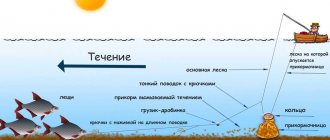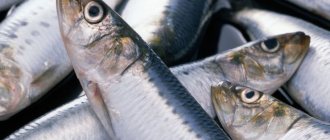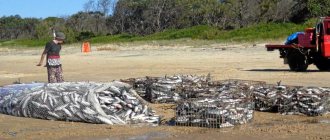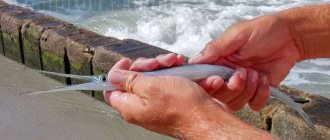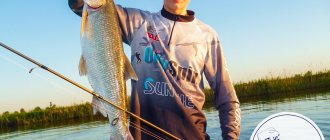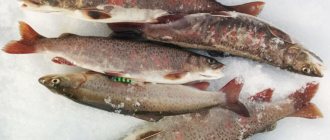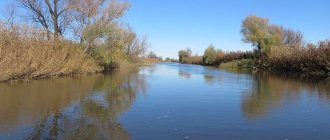What is a fool, a ball, a roll, a jerk, a pull?.. A simple technique for fishing with a drill. The only one capable of bringing such prey in winter as chub and ide.
Jigs are a collection of successful lures, each of which can become a star in certain conditions. And, of course, these conditions are determined by where the fishing takes place. And this could be the assertive and fickle current of the Volga, entirely dependent on the operating mode of hydroelectric power stations, the gates of which can be closed when you are waiting for this very current, and at night it suddenly hits so hard that it seems that the ice will now break through and carry it along with the tent directly to Caspian Lake to hell!..
Meanwhile, the jig can sway quietly and lazily in sleepy silence somewhere in a swamp where oaks and maples frozen in the ice, left over from the forests, grow. The swamp is called a flood zone and, despite its modest provincial life, it can present an angler with a reelless jig at the end of winter and spring with a golden rudd weighing a kilogram or a sharp-eyed ide with disgustingly protruding lips. Otherwise, a simple silver “pellet” will slip under the ice on a forest lake and pull out from under the loose ice a blue-black perch with a ruby bloodworm bitten in its mouth.
Durilka is a very simple tackle
The fool is also called a roller, a ball, a jerk, or a stretch catch. But in fact, the tackle is quite simple, but no less effective for this. And it is the only one capable of bringing in winter and, of course, on spring ice such prey, which is not common during the ice season, like chub and ide. But what does this have to do with the jig from the declared triad? Yes, in its classic form, the fool is equipped with a regular hook on a leash, but I had to catch the white-eyed sow with a white or red plastic jig tied to the long leash of the fool. It happened on the right bank of the Volga, on a fast current, where there was no point in fishing with other gear. Instead of a plastic jig, you can more successfully use jigs with a fluorescent coating, that is, luminous ones, especially if fishing occurs at great depths. And a jig often shows better results than a hook.
Types of tyrants
Tackle with this name is fishing equipment, which consists of a fishing line, cord or nylon core about 50 m long, wound on a reel. More reliable is the tyrant who is mounted on a 1 meter long rod with guide rings and a spinning reel. A leader equipped with a weight and a set of hooks is attached to the main line; it is called a stake. With the help of a simple device, you can catch several trophies at once in one cast. Use it both at a specific place and on the go. The primary purpose of the tyrant was to catch sea predatory fish, but it is also practiced for the peaceful inhabitants of the reservoir.
Common differences between the options for this equipment are:
- length of undergrowth and leashes attached to them;
- sizes of hooks and their number;
- color of the bait used;
- weight and shape of the sinker;
- methods of attaching feathers.
Based on these components, there are two most commonly used types: “noticeable” tyrants and “playing” ones. The first feathers on the hooks are much larger and have shorter undergrowth. Such models perform well on bright autumn days, when the water is much darker than in the warm season. The second ones have smaller feathers and a long undergrowth. They serve well in clear water in spring and summer at dawn and before sunset, as well as in moments of complete calm.
To learn more:
How to make catchy tackle for crucian carp?
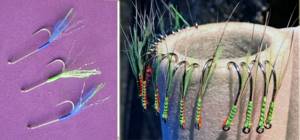
Well, now, what is a fool, a ball, a roll, a tug, a stretch?..
This is just a combination of a heavy sliding weight, tied below a meter-long leash with a hook, and a side-type rod with a hard metal nod. This is, so to speak, a rough scheme for strong currents and power fishing. There are more delicate options in the form of a winter fishing rod with stop legs and an open reel. The nod is also used in metal or lavsan, of the “spring” type, that is, with two or three retractable plates located in one cage. It all depends on the strength of the current in the place of fishing. The weight can also vary between 10-35 grams.
The sinker can be in the form of a ball that rolls well with the current. Most often, the ball sinker is placed in a sliding version, the diagram of which looks like this. The ball is put on the main fishing line, a swivel is tied below, the upper loop of which is protected by a bead or cambric so that the load does not break the knot. A leash is attached to the bottom loop of the swivel, the length of which can be 1-1.5 meters. Some people use longer leashes. The diameter of the main line is 0.2 mm, the leader is 0.15-0.17 mm. Hook - No. 4-5 Russian numbering.
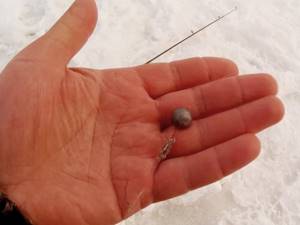
Another scheme is a pear-shaped end weight with an eye, to which the main fishing line is attached, and 10-15 cm higher - a meter-long leash with a hook. Instead of a hook, you can use a jig. It all depends on what kind of fish the tackle is aimed at. By the way, instead of a load, you can also tie a heavy luminous jig, baiting it with a large brush of bloodworms or worms. In this option, in addition to “white” fish - bream, roach, bluegill, sopa - you can take bersh and pike perch, especially if you put chopped sprat on the jig hook.
Gear selection
When fishing for chub in winter on the first ice, various tackles are used. But the likelihood of getting a decent catch increases if you take a rod with a jig with you. Such a fishing rod must be equipped with a long nod of medium hardness and a thin transparent fishing line, the thickness of which should be no less than 0.14 and no more than 0.2 mm. The use of thinner fishing line in the case of chub is not advisable, because large individuals are quite strong, so they can easily break the gear.
In addition to a winter fishing rod with a jig, during winter fishing for chub the following is used:
- spinning rod (for fishing in open waters),
- bottom tackle fool,
- float rod (for fishing on warm rivers).
Depending on the choice of gear, the type of groundbait, bait, fishing technique, and number of retrieves may change.
Spinning rod equipment
First you need to take care of the rod itself; it should be light and inertia-free. The length of a spinning fishing rod can be 2-2.5 m, and the test can be no more than 20 g. It is recommended to equip the spinning rod with a strong fishing line with a cross-section of 0.2 mm and a length of 120-150 m. A thin fishing line will help you feel the bite of both large fish and and young animals.
If fishing takes place not on a lake, but on a river with warm water and an open current, then monofilament is more suitable for catching chub. One of the largest representatives of carp fish is known for its caution and suspicion, and such a fishing line is almost invisible in the water. The bait used is spoons, twisters and wobblers with hooks of size 4-6.
Winter fishing rod
A durable rod with a strong fishing line is the basis for successful chub fishing in winter using a jig. The fact is that this fish is quite strong and playful. She takes the bait willingly and with a big jerk. If a fisherman wants to catch a trophy specimen, then the minimum thickness of the fishing line should be 0.17 mm. If you want to get a big catch, but the size of the fish does not matter, then a fishing line with a diameter of 0.1 mm is suitable. Such gear is good for catching chub on lakes.
Equipment for fishing on rivers with intense currents is somewhat different. In this case, a fishing line with a cross section of 0.18 mm is used. The thread is equipped with a sliding sinker and a leash made of thinner fishing line (0.12−0.14 mm). The length of the leash should be approximately 25-30 cm.
Particular attention should be paid to the elasticity of the six. To catch a chub, a flexible nod is used if fishing is carried out in a body of water with a small current. A hard six is used in cases where fishing is carried out in fast-flowing reservoirs.
Jigs and natural baits
The tip of the line of the winter fishing rod is equipped with a jig. Experienced fishermen advise using baitless baits:
- Multi-colored round jigs made of tungsten. The hooks of the nozzles are equipped with bright cambrics and beads that can be easily moved.
- Nozzles in the form of hemispheres with eyes of various colors. If you complete the product with multi-colored beads, the chub will definitely react to the irritable bait and want to swallow it.
- Factory products. Drobinka (more attractive to chub), uralka, cone, larva, ant. Also suitable are jig models such as cone, disc, droplet or oatmeal.
In addition to baitless baits, live components are also used when catching chub . You can use bloodworms (also suitable for summer fishing), bark beetle larva or flies. Burdock moths can also attract small fish. An additive made from natural ingredients will make the bait more realistic and help you get a big catch. But one nuance should be taken into account: such baits attract not only chub, but also bream, perch or rudd.
Operating technique
The most exciting and interesting fishing for tyrants will be using a boat or boat, especially in the morning and evening hours. At this time of day, fish gather at a depth of 20-35 m throughout the entire water area, and during the day - in the range from 35 to 55 m and near underwater gorges.
To learn more:
General information about fishing equipment
It is better to go sea fishing together. Before casting the gear, you need to study the direction of the current and wind: if it is from the shore, first fish shallow areas, and from the sea, start from the depths.
Having decided on the place of fishing, the vehicle is “anchored”, the lead weight is released and, unhooking the hooks one by one, the stake is immersed. After waiting until it is in the water, the tackle is taken by the rod or handle, and the main line, under the influence of gravity, begins to quickly unwind on its own. To insure against a sharp or unexpected bite, the handle is tied to the side (the rod is held in the hands).
The fishing technique consists of periodically twitching the tackle. The moment of bite is transmitted along the line with weak or strong jerks.
After the first twitch, there is no need to rush to remove the cord from the water; on the contrary, it is necessary to lower it even deeper. In this case, more than one fish will be able to catch on the free hooks.
They lift the tackle up slowly and straight to the bottom of the boat. By selecting the main line, you can see all the caught fish in the water. It is removed from the hooks one by one, but the bet itself is not completely removed. Also, do not hold the catch suspended, as it may come loose. Having removed all the fish, the undergrowth is again lowered into the water, after which the required length of the main line will also sink to the bottom.
How to make a tyrant with your own hands
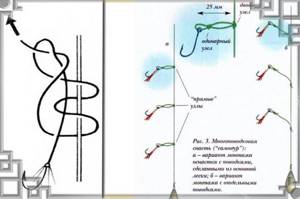
Having selected all the necessary tools and consumables, such a design can be made at home. To do this, the main line should be attached to the rod or wound on the reel. Using reliable carabiners, additional fishing line is attached to it - a stake, an important part of fishing gear. It is she who holds the leashes (up to 10 pieces), located at step-by-step distances from each other.
The length of the step is calculated taking into account what kind of fish will be hunted. For example, to catch horse mackerel, one leash from the other should be at a distance of 25-30 cm, and to fish for mackerel, they are attached within 60 cm. In its appearance, the tackle should resemble tree branches, that is, it is advisable for the leashes to stick out in different directions.
To learn more:
How to make a mandula with your own hands
A sinker is tied to the end of the chosen bet, the shape and weight of which is determined depending on the conditions and location of the expected habitat of the school. In shallow water and in stagnant sea water, a lead weight of 100-200 g is sufficient. In places with great depth, the weight of the load should be about 400 g. It is desirable that it be cone-shaped. Experienced fishermen, unlike beginners, have in their arsenal several betting configurations with “steps” of different leash lengths and sinkers of different weights.
The most difficult process of constructing your own fishing gear is the routine of attaching colored baits to the hooks. This activity requires utmost attention, patience and accuracy. Having selected the desired feather, excess sections are cut off from it (after comparing it with the size of the hook) so that the bait protrudes from the sting at a distance of about 2 cm. Using a thin fishing line (woolen thread is also suitable), the bait is attached to the hook with your favorite fishing knot. For reliability, the joints are covered with waterproof glue or nail polish. The following nuances are taken into account:
- “noticeable” tyrants are framed with white goose feathers, adding black from a jackdaw or sheep’s wool to the sides;
- “playing” tyrants complete feathers from guinea fowl and turkeys, adding white goose feathers;
- threads are chosen in yellow, green, red, crimson colors.
Tackle designed with your own hands will give the fisherman additional confidence in his own abilities. And how to make a tyrant and with what rates to staff, everyone decides for himself.
How to store tackle
We figured out how to knit a tyrant and when to use it. But an equally important part of its durability is careful care and compliance with storage rules. Returning from fishing, the stake must be disconnected from the main fishing line (the weight must also be unhooked). Wrap the fishing line with leashes and hooks on a piece of board or cardboard prepared in advance, and then store it in a dry place so that the metal parts of the tackle do not rust.
To learn more:
Flasher: what kind of device is this?
